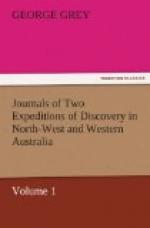Length from mouth to end of curve between forks of tail 10 inches. From mouth to commencement of wing-like fin 2.7 inches. Length of wing fin 6.7 inches. of dorsal fin 2.0 inches. of pectoral fin 2.2 inches. of anal fin 1.3 inches. of upper fork of tail 2.2 inches. of lower ditto 3.2 inches. Length from mouth to end of gill 2.2 inches. Breadth of wing fin 6 inches. 13 spines in each of these wings. Breadth between eyes 0.11 inches. Depth of fish 1.6 inches. Breadth of thickness 1.6 inches. Diameter of the eye 0.65 inches.
Under-jaw projecting; sides, pale green; back, blackish-green; belly, white; five first spines in wing fin, greenish; others white; wing-fin dark green with a transparent band running nearly up the centre from the back; pectoral fin, transparent, with a dark green spot, nearly an inch square, about the centre of its lowest extremity; tail, dark green, edges light.
November 26. Latitude 16 degrees 32 south; longitude 117 degrees east.
After crossing about the 22nd parallel of south latitude we fairly entered into the region of flying fish, and dolphins as they are commonly called; tropic birds were now also frequently seen, which had not up to this moment been the case; we often also met hereabouts with a dark-coloured bird with bronzed wings, having a cry precisely like a Snipe. I know not the name of this bird. The more beautiful and largest Sea-jellies (acalepha) had now disappeared, although the more minute ones were as numerous as ever.
Remarks.
It therefore appears to me that we have, in coming from the southward to this point, passed through three great regions, or zones, of animal life, one extending from as far to the southward as I have yet been, namely 36 degrees south latitude to 31 degrees south latitude; this zone was inhabited by numerous Sea-jellies (acalepha) of the smaller kind, by porpoises and whales, as well as by immense varieties of the Petrels or Procellariae.
The second zone extending from 31 degrees south to 22 degrees south latitude was inhabited by immense numbers of the larger and more beautiful kind of Sea-jellies (acalepha) particularly by those that have the power of stinging. Within this zone I saw but one whale, one shoal of porpoises, and not a single one of the long-winged water birds or Petrels; in fact I but once in the whole of this distance saw any birds; there were also here a great variety and numbers of Sea-jellies (acalepha) of the smaller kinds. Do then the larger acalepha in this zone perform the office of the birds in the more southern one, and prey upon the smaller species of their own kind?
The third zone is the one with which I have commenced the journal of this day.
Water snakes.
November 29. Latitude 15 degrees 26 minutes 32 seconds south; longitude 122 degrees 3 minutes east.




